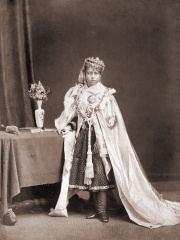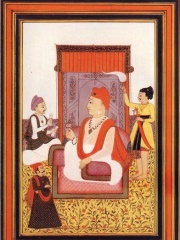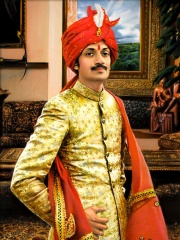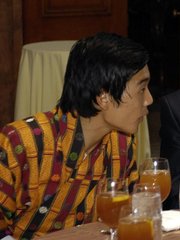




The Most Famous
NOBLEMEN from India
Top 6
The following people are considered by Pantheon to be the most legendary Indian Noblemen of all time. This list of famous Indian Noblemen is sorted by HPI (Historical Popularity Index), a metric that aggregates information on a biography's online popularity.

1. Murad Bakhsh (1624 - 1661)
With an HPI of 63.95, Murad Bakhsh is the most famous Indian Nobleman. His biography has been translated into 16 different languages on wikipedia.
Mirza Muhammad Murad Bakhsh (9 October 1624 – 14 December 1661) was a Mughal prince and the youngest surviving son of Mughal Emperor Shah Jahan and Empress Mumtaz Mahal. He was the Subahdar of Balkh, till he was replaced by his elder brother Aurangzeb in the year 1647.

2. Shah Jahan Begum of Bhopal (1838 - 1901)
With an HPI of 60.17, Shah Jahan Begum of Bhopal is the 2nd most famous Indian Nobleman. Her biography has been translated into 17 different languages.
Shahjahan Begum (29 July 1838 – 16 June 1901) was the Nawab Begum of Bhopal (the ruler of the Islamic principality of Bhopal in central India) for two periods: 1844–60 (her mother acting as regent), and secondly during 1868–1901.

3. Zinat-un-Nissa Begum (1643 - 1721)
With an HPI of 57.40, Zinat-un-Nissa Begum is the 3rd most famous Indian Nobleman. Her biography has been translated into 18 different languages.
Zinat-un-Nissa Begum (Persian: زینت النساء بیگم; 5 October 1643 – 7 May 1721) was a Mughal princess and the second daughter of Emperor Aurangzeb and his Chief consort Dilras Banu Begum. Her father had conferred upon her the honorable title of Padshah Begum.

4. Narayan Rao (1755 - 1773)
With an HPI of 56.27, Narayan Rao is the 4th most famous Indian Nobleman. His biography has been translated into 15 different languages.
Narayanrao (10 August 1755 – 30 August 1773) was the 10th Peshwa of the Maratha Confederacy, serving from November 1772 until his assassination in August 1773. He was the third and youngest son of Balaji Baji Rao (also known as Nana Saheb) and Gopikabai, and the younger brother of Madhavrao I. He was married to Gangabai Sathe, the daughter of Krishnaji Hari Sathe, and the couple had a posthumous son, Madhavrao II, who later succeeded him as Peshwa. Narayanrao ascended the throne at the age of 17 following the death of his brother Madhavrao I. His reign was short and politically turbulent, marked by growing tensions between him and his uncle Raghunathrao, who had expected to succeed as Peshwa. Although Narayanrao initially sought to maintain his elder brother’s policies and continue reforms aimed at stabilizing the administration, his inexperience and strained relations with senior ministers—especially Raghunathrao—led to internal discord within the Maratha Confederacy. His administration relied heavily on experienced statesmen such as Sakharam Bapu Bokil and Nana Fadnavis, who advised him in state matters. However, conflicts within the court and factional rivalries culminated in a conspiracy that led to his assassination at Shaniwarwada in Pune on 30 August 1773. His death triggered a succession crisis, leading to the installation of his infant son Madhavrao II as Peshwa under the regency of the Barbhai Council, a coalition of influential Maratha nobles.

5. Jigyel Ugyen Wangchuck (b. 1984)
With an HPI of 40.04, Jigyel Ugyen Wangchuck is the 5th most famous Indian Nobleman. His biography has been translated into 14 different languages.
Prince Dasho Jigyel Ugyen Wangchuck (born 16 July 1984) is a Bhutanese prince. Born the second son of the King of Bhutan Jigme Singye Wangchuck, he was the heir presumptive to the throne of Bhutan until the birth, on 5 February 2016, of his nephew Jigme Namgyel Wangchuck, the son of his older half-brother and current King Jigme Khesar Namgyel Wangchuck.

6. Manvendra Singh Gohil (b. 1965)
With an HPI of 38.72, Manvendra Singh Gohil is the 6th most famous Indian Nobleman. His biography has been translated into 19 different languages.
Manvendra Singh Gohil (born September 23, 1965) is a son and probable heir of former Maharaja of Rajpipla. He is considered to be the first openly gay prince in the world, and he is known for being one of India's foremost LGBT activists. He is the Managing Director and Co-founder of Search Ends Inclusion Impact, an initiative driving transformative change through inclusive practices. He runs a charity, the Lakshya Trust, which works with the LGBT community.
People
Pantheon has 6 people classified as Indian noblemen born between 1624 and 1984. Of these 6, 2 (33.33%) of them are still alive today. The most famous living Indian noblemen include Jigyel Ugyen Wangchuck, and Manvendra Singh Gohil. The most famous deceased Indian noblemen include Murad Bakhsh, Shah Jahan Begum of Bhopal, and Zinat-un-Nissa Begum. As of April 2024, 1 new Indian noblemen have been added to Pantheon including Jigyel Ugyen Wangchuck.
Living Indian Noblemen
Go to all RankingsDeceased Indian Noblemen
Go to all RankingsMurad Bakhsh
1624 - 1661
HPI: 63.95
Shah Jahan Begum of Bhopal
1838 - 1901
HPI: 60.17
Zinat-un-Nissa Begum
1643 - 1721
HPI: 57.40
Narayan Rao
1755 - 1773
HPI: 56.27

